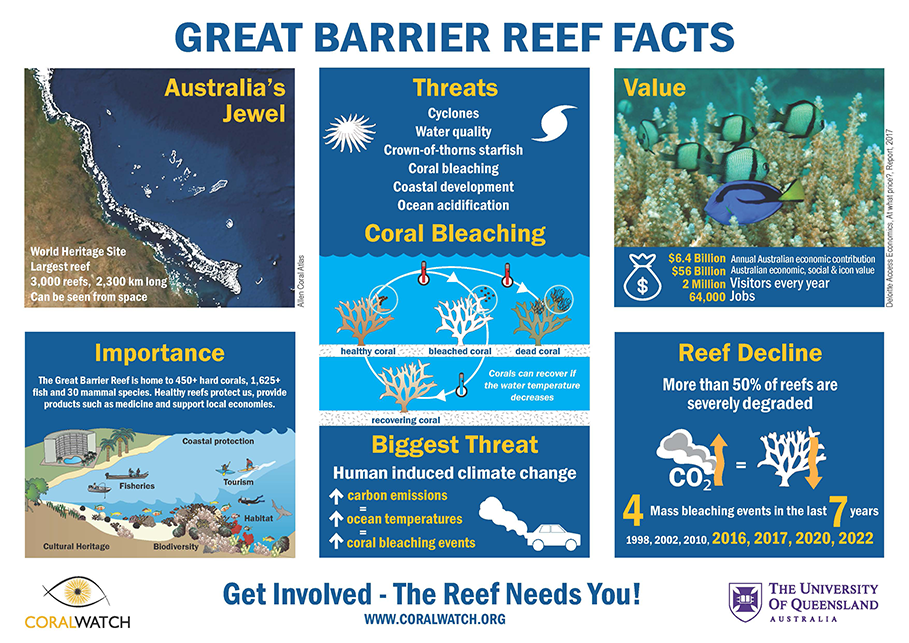
Facts
Save Reefs From Home
Coral Reef /Great Barrier Reef Facts
How much coral is lost?
• In last 30 years, 50 % of the world’s coral reefs have been lost.
• In the last 20 years four main bleaching events
– 1998 – 16% worlds reefs impacted, 60% GBR affected
– 2002 – >70% reefs GBR affected
– 2016 – 12% worlds reefs bleached, 95% northern GBR bleached, 29% GBR lost
– 2017 – 19% reefs GBR lost, mostly in central section
• Back-to-back bleaching in 2016-2017 lead to a loss of >50% with zero recovery in between
• GBR starts to recover after back-to-back bleaching
• Northwestern Australian reefs were also badly impacted
– 2016 – 60-90% of reefs bleached and died, first time bleaching on record in Kimberley – 2017 – risk of moving further south along Western Australian coast
Isn’t most of the reef already dead? Why should we even try?
⦁ The reef is not dead, it is stressed through increasing temperatures and bleaching. If water temperature drops quick back to normal, corals can survive.
⦁ It’s not too late to save our coral reefs.
⦁ We need to act now to give the reef time to bounce back.
⦁ You don’t need to live next to the reef and you don’t need to be a scientist to help the reef.
⦁ The reef has bought me so much joy in my lifetime; I want my children to experience it as well.
⦁ It’s world’s largest reef, Australia’s jewel and one of the most fascinating places
⦁ Explore it yourself and you will care and help to preserve it for future generations
⦁ Become a CoralWatcher and help to collect data on coral health and see the reef recover.
⦁ A lot of science is lost when communicating it to the public, especially through media outlets
Inspirational people involved in sustainable living
⦁ Kylie Ahern – Living off grid
http://www.kylieoffgrid.com.au/
⦁ Rogue Ginger – Zero waste
http://www.therogueginger.com/
Value of the Great Barrier Reef
• 56 billion total economic, social and icon asset value
• $6.4 billion Australian economic contribution annually
• 64,000 jobs supported by the GBR
• 2 million visitors every year
What are the main causes of mass bleaching / coral reef mortality?
There is only one answer: Climate Change and Global Warming caused by humans, including in Australia, but what does this mean:
• Increased carbon emissions
– Global CO2 concentrations passed 400 ppm – the last time CO2 levels were this high, humans did not exist
• Increasing ocean temperatures
– Limiting warming to below 1.5°C is required to preserve >10% of coral reefs worldwide
• Sea-level rise
– The last half century, sea level rose about 2-3 mm and by 2100 sea-level-rise is expected to be 0.26 to 0.98 m globally and 0.68 m on the GBR
– At least $226 billion of assets and infrastructure will be exposed to inundation if sea levels rise by 1.1 m
• Ocean acidification
– Ocean acidity increased by 26% since 1850, roughly 10x faster than any time in the last 55 million years – Around 1/3 to half of the CO2 released by human activities is absorbed into the oceans causing the ocean to become more acidic. This affects corals and shell-forming organisms badly, including on the GBR
What can I do to reduce my carbon footprint and help save the reef?
High impact actions
⦁ Have one fewer child
⦁ Live car free / buy more efficient car
⦁ Avoid one flight per year
⦁ Purchase renewable/ green energy – coal free
⦁ Eat a plant-based diet
Moderate impact actions
⦁ Be energy efficient – do more with less
⦁ Travel smarter, live local and use public transport
⦁ Buy energy efficient products
⦁ Reduce, Reuse, Recycle
⦁ Eat and buy local


